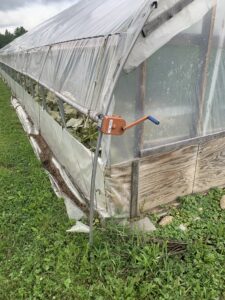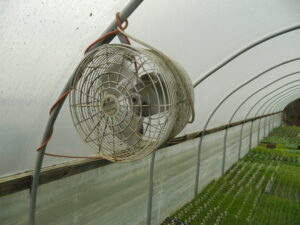I had the pleasure of facilitating a workshop at the 2019 NOFA-MA Summer Conference about Ventilation in Greenhouses and High Tunnels. It provided an opportunity to collect information from various sources, ground truth observations with growers, and to revisit some fundamentals. The big takeaway, for me, is that there are many, many ways to ventilate a protected culture environment and opportunities for improvement abound. I hope this review provides a framework for troubleshooting some issues that may be common in the field.
Background
Greenhouses and high tunnels provide a protected area for growing vegetables. Greenhouses can be used to start plants and high tunnels can provide season extension. These partially enclosed spaces, however, require attention to climate control. In addition to heating, ventilation and air circulation are important practices that help to provide consistent, well-distributed, healthy conditions for plant growth and production.
Ventilation vs. Circulation
It is important to differentiate two types of air flow that are needed in high tunnels and greenhouses: ventilation and circulation.

Ventilation is the active exchange of inside air for outside air. This exchange is important to remove heat and humidity from inside the structure and replace it with drier, cooler outside air. This also helps to replenish carbon dioxide which is consumed in the process of photosynthesis. Ventilation is accomplished in several ways including end-wall exhaust fans combined with inlet louvers, passive peak vents or ridge vents combined with roll-up sides, roll-up sides alone in an area with reliable crosswind, or even large doors on each endwall.

Circulation is mixing the air inside the structure. This is most often accomplished with horizontal air flow (HAF) fans. Circulation is important to ensure each square foot of growing space is getting roughly equivalent growing conditions. HAF’s push the air around the growing area and should ensure that there are no areas without some air flow. These fans help to make up for the limitations of ventilation that often lead to zones of no air flow, typically in the corners.
If you ventilate without circulation, you run the risk of having corners or other zones not benefiting from the exchange of air.
If you circulate without ventilation, you run the risk of having conditions in the structure growing overly hot and humid leading to plant stress and disease.
Passive vs. Active Systems
When considering ventilation of a high tunnel or greenhouse, there are both active and passive options.
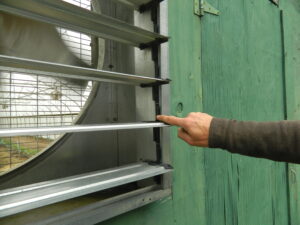
Active systems use electric motors to spin fans and move air. Active systems, therefore, require electricity to operate and siting of a high tunnel or greenhouse may impact the feasibility of this. An example of an active system includes two end wall exhaust fans, two inlet louvers on the opposite end wall and a thermostat that opens the louvers and turns the fans on when the temperature is above 85 °F.
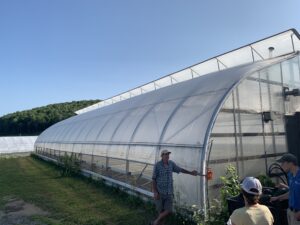
Passive systems use openings in the envelope of the structure to allow airflow to happen naturally. Passive systems are often preferred over active systems due to their inherent lower initial cost and energy efficiency and because they offer greater flexibility in siting (e.g. electric utilities are not needed). However, passively ventilated tunnels depend on steady, gentle prevailing winds to assist with ventilation. Avoid siting these tunnels too close to large structures, dense tree lines, or other obstructions that will prevent ventilation.
Airflow Requirements
Guidance for ventilation flow rates are provided as volumetric flow of cubic feet per minute (CFM, ft3/min) per square foot of growing area in the publication, Greenhouse Engineering by Bartok and Aldrich (NRAES-33).
For hot season growing use 8 CFM/ft2 of growing space for cooler season growing use 2 CFM/ft2. For a 30 ft x 96 ft tunnel the total growing area is approximately 2,900 ft2. The hot season ventilation requirement is, therefore 23,200 CFM and the cool season requirement is 5,800 CFM. If a structure is used in both cool and hot seasons, two stages of ventilation can be used with two fans controlled by a two stage thermostat. A variable speed control can also be used to adjust the ventilation flow rate. More resources for winter growing are available on our Winter Growing page.
Guidance for circulation flow rates is 25% of the overall growing volume per minute (also from Bartok and Aldrich’s Greenhouse Engineering). For a 30 ft x 96 ft tunnel with 15 ft peak, the total volume is approximately 34,000 ft3. One quarter of that volume is approximately 8,500 ft3, so the total HAF flow rate required is 8,500 CFM (ft3/min).
Equipment and Controls
Ventilation Fans & Inlet Louvers
Exhaust ventilation fans can be found in sizes typically ranging from 12” to 48” in diameter, cost $150 to $1,000 each, and provide between 1,000 and 22,000 CFM each respectively. Exhaust fans can be direct drive or belt driven and can be setup to run as single, dual or variable speed. Multiple fans can also be setup with staged temperature controls to achieve at least two levels of ventilation for different growing seasons. Exhaust fans are typically all installed on a common endwall with inlet louvers installed on the opposite endwall to provide sweeping flow. Inlet louvers should be sized with an area equal to the exhaust fans. Motorized louvers with a flange to ensure good sealing are recommended to improve energy efficiency and plant health by reducing drafts. Louvers cost $50 to $250 each.
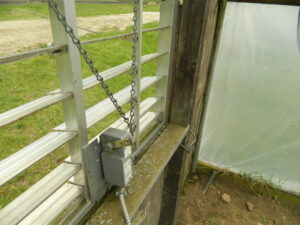
Roll-up or Fold-down Sides
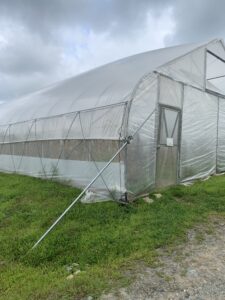
Roll-up sides can serve as both inlet and outlet for ventilation depending on the siting, use of other vents and prevailing wind. This method of ventilating is typically accomplished using sheets of plastic that run the length of the tunnel and are rolled up around a pipe to an appropriate degree of opening for the desired conditions. The rolling mechanism can be manual with a simple pipe and tee or can make use of a gear hand crank. Additionally, motorized roll-up motors are available with controllers that automate this task.
It is also possible to achieve the same side venting using a fold-down or roll-down system. Some of these use inflation fans to “blow up” side curtains to seal them closed while others use rope and pulleys to lift or lower the side walls.
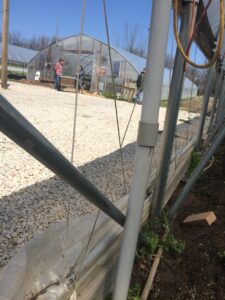
Ridge and Peak Vents
Ridge vents and peak vents are sections of the roof that are designed to open and allow warm, humid air to escape out the top. The differ slightly in their design with ridge vents resulting from one side of the tunnel terminating above the other side at the ridge leaving a vertical section that can be opened or closed. Peak vents are typically a section of roof that runs the length of a gothic type house which can be opened or closed. Both offer an alternative to exhaust fans. When combined with roll-up sides, these vents can provide very effective, quiet, and energy efficiency ventilation. Both are typically easiest and least costly to install when the tunnel or greenhouse is first built. They are operated by a motor and a rack and pinion and can be adjusted to different levels of opening depending on the temperature and the control system.
Gable Vents
Ventilation openings placed high toward the very top of the end wall are called gable vents. These can be effective when combined with roll-up sides as a passive ventilation option.
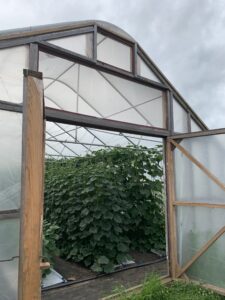
Horizontal Air Flow (HAF) Fans
Horizontal air flow (HAF) fans are typically 12” to 24” in diameter, cost $80 to $300 each, and provide between 1,000 and 5,250 CFM each respectively. Some growers have had success using inexpensive box fans, noting that even though they need more of them per house and also need repeated replacements they are less expensive than commercially available HAF’s. In either case, it is important to note that HAF fans provide the rated flow for a certain length of “throw.” To ensure well-distributed mixing flow throughout the growing area, it is generally recommended to place HAF fans every 50 feet along the length of flow. In practice, especially with dense vegetation in certain crops (e.g. tomato and cucumbers) a maximum distance between HAF fans of 20-30 feet is more appropriate. HAF fans are typically installed in a “race track” layout intended to stimulate flow all around the growing area. This layout does sometimes leave at least two corners with relatively low flow in practice and growers should test the intended layout before finalizing it.
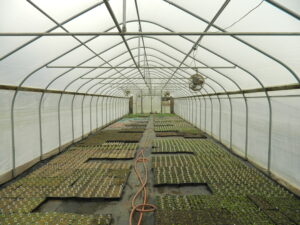
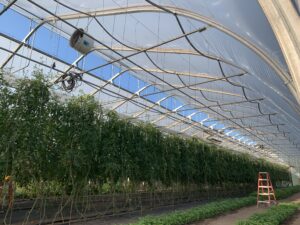
Heaters
Although this article is mainly focused on ventilation, heaters are useful for improving the impact of ventilation when humidity control is needed. Heated air can carry more moisture which allows ventilation air flow to reduce humidity more effectively. There are a number of factors involved in sizing a heater for a greenhouse or high tunnel including the size, the desired indoor temperature, the outside temperature, and the envelope of the tunnel. More information about determining heat load for greenhouses and tunnels can be found in the post, Calculating Greenhouse and High Tunnel Heat Loss.
Switches
The most basic controls take the form of switches that turn fans on or off. These are inexpensive and easy to install, but depend on an operator to make changes. It is common to have ventilation fans and HAF fans on separate switches to provide flexibility in their operation.
Thermostats
The next step up is a thermostat, which is a switch that opens or closes automatically based on the temperature that has been set on it. Thermostats can be setup for heating control (close on dropping temperature) or cooling control (close on rising temperature). The sensing probe of the thermostat should ideally be aspirated (air flowing over it), shielded from radiation gain (the increase in heat due to incident sunshine), and located to accurately measure the air temperature the plants are experiencing.
More information about selecting and using thermostats is available from John Bartok’s article in Greenhouse Management and in our post about Thermostats for Agriculture.
Wax Cylinders
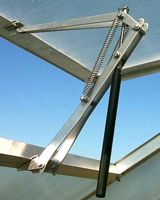
Wax cylinders can be used to open and close louvers, peak and gable vents when electricity is not available. These sealed cylinders are filled with wax that expands with increasing temperature. That expansion results in increased pressure and moves a piston out. They come in a variety of load ratings and can be adjusted for very specific temperature response. More information about wax cylinders for opening and closing tunnel vents can be found in our post, Improved Ventilation for High Tunnels.
Integrated Controls
A higher level of control system comes in the form of an integrated control. These systems monitor multiple inputs such as different temperature readings and humidity and control multiple outputs. Previously, these have been considered too expensive for smaller farms or individual tunnels. However, the prices have been reduced significantly. These controls can be helpful for automating more complex high tunnels or greenhouses that include heating systems, ventilation fans, circulation fans, roll-up sides and even irrigation. These systems can generally be accessed from a computer or smartphone for checking conditions and changing setpoints.
Pitfalls, Tips and Tricks
Poor Ventilation
Inadequate ventilation can lead to excessive heat and humidity. High temperatures can lead to plant stress and reduced yield while high humidity can lead to fungal diseases. If you are experiencing high temperatures and have exhaust fans running constantly or have all passive ventilation options completely open, you likely have inadequate ventilation. If you are seeing wide-spread fungal disease, you likely have inadequate ventilation. The effectiveness of your ventilation system can change over the course of the growing season as increased vegetation introduces more restriction to air flow. You should be able to stand in the middle of the tunnel or greenhouse and feel a comfortable breeze.
Poor Circulation
Inadequate circulation can lead to inconsistent conditions throughout the tunnel or greenhouse. This can show up as hot spots with high temperature, cool spots with low temperature, areas of high humidity, and condensation. Look for leaf movement in every part of the tunnel or greenhouse as a sign that there is air flow present. Strips of survey tape, cut to equal lengths and tied to the tunnel framing to hang down can also be helpful to show where air is flowing and where it is not.
Labor vs Automation
Keeping tabs on a high tunnel or greenhouse can be a real chore that consumes a lot of time and attention often resulting in heightened anxiety. Automating certain controls can reduce the amount of labor required considerably. This convenience and peace of mind comes at a cost, typically $1,500-$2,000 for a controller, sensors and roll-up motors in addition to any fans already in place. With a labor cost of $15 per hour and 15 minutes of labor required per house twice daily, an automated controller will pay for itself in about 250 growing days.
Share this post!
http://go.uvm.edu/tunnelventilation
References
Bartok, J. (2012, October 29). Improving thermostat performance. Retrieved August 10, 2019, from Greenhouse Management website: https://www.greenhousemag.com/article/gm1112-using-thermostats-greenhouses/
Bartok, J., & Aldrich, R. (1994). Greenhouse Engineering, NRAES – 33. Retrieved from http://blog.uvm.edu/cwcallah/files/2021/03/NRAES-33_Web.pdf
Blomgren, T., & Frisch, T. (2007). High Tunnels: Using Low-Cost Technology to Increase Yields, Improve Quality and Extend the Season. Retrieved from USDA NE SARE and University of Vermont Center for Sustainable Agriculture website: http://www.sare.org/Learning-Center/SARE-Project-Products/Northeast-SARE-Project-Products/High-Tunnels
Brockman, T., Cummings, C., & Hake, J. (2015). A Guide to Season Extension for Illinois Specialty Crop Growers. Retrieved from http://thelandconnection.org/sites/default/files/TLCSeasonExtensionGuide-forweb_0.pdf
Callahan, C. (2019, April 15). Thermostats for Agriculture – UVM Extension AgEngineering. Retrieved August 10, 2019, from http://go.uvm.edu/thermostats
Ebert, K., & Rivard, C. (2012). Kansas State High Tunnel Video Series. Retrieved from Kansas State University and USDA NC SARE website: http://www.sare.org/Learning-Center/SARE-Project-Products/North-Central-SARE-Project-Products/Kansas-State-High-Tunnel-Video-Series
High Tunnel Manual. (n.d.). Retrieved April 9, 2019, from Penn State Extension website: https://extension.psu.edu/high-tunnel-manual.
Upson, S. (2014). High Tunnel Hoop House Construction Guide (An Agricultural Division Publication. NF-HO-14-01). Retrieved from Noble Foundation website: https://web.extension.illinois.edu/bcjmw/downloads/54183.pdf




